Radiant Leaks / Floor Discoloration / Water Damage
I’ve got a homeowner that is experiencing spotty discoloration and bubbling of the finish on their pre-finished wood floor. The floor was glued directly to the old concrete floor in a 60+ year old house. It is unclear if there is a vapor barrier below the slab. There is no vapor barrier between the slab and the wood floor. The slab encapsulates a copper pipe radiant floor system that was installed when the house was originally built. There is a shower in relatively close proximity to all of the spotting and the most severe spotting is closest to the shower (within 5 – 10′ or so). The shower is a built-in and is very old. Some of the grout is severely cracked. There is also high moisture content in the walls surrounding the shower. I’d say that the shower is definitely leaking some water…. However, floor discoloration and finish bubbling is only occurring in a dozen or so places…anywhere from 1′ to 15′ or 20′ away from the shower. The spots are no bigger than about 4″ to 8″ in diameter and there isn’t any floor cupping that i could see. Are these spots being caused by A) radiant leaks B) a leaky shower C) ground moisture or D) something else!? I used infrared to map out the pipes. Check out the pictures!!! Thanks!
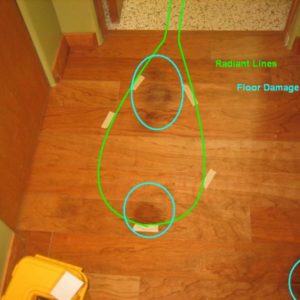
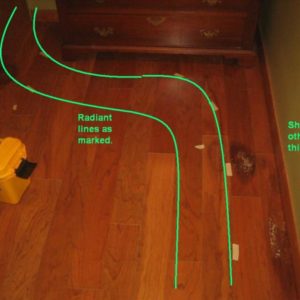
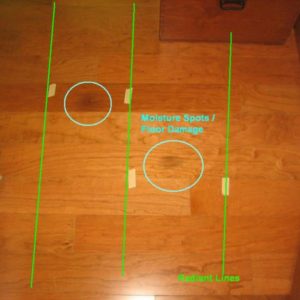
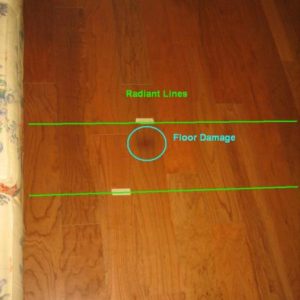
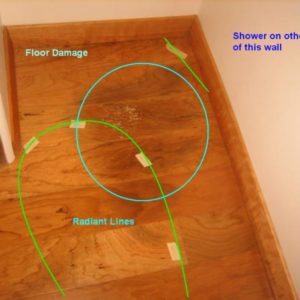
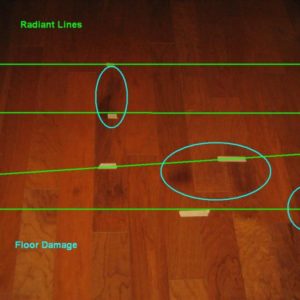



















Replies
The only way is to carefully cut out and look at the back of the pieces in question. Does the owner have any extra wood pieces to fill back in?
well
Copper in concrete from the 60's could have some pinhole leaks. I'd pressure test it if it can be isolated.
How hot is the floor heat running? Had a similar occasion, but this with pex in gypcrete. Some of the engineered bamboo discolored-not necessarily on the runs of pipe (we had scaled pictures of the piping b/4 gypcrete was placed). Manufacturer suggested too high heat from the boiler could cause it. Homowner did not replace but did lower their operating temp. No more discolored patches. They were not as severe as what you show however.
best of luck.
Could be many things -- pinhole leaks, overheating, the cat, condensation under furniture during warm weather, etc.
If it was due to leaks in the tubing I'd expect the damage to be a touch more dramatic -- closer to what you see near the (probably leaking) shower. And you'd expect the spots to run along the length of the tubes to a degree. But water can do strange things, so it's hard to say. And 60 years is a long time for copper to last in concrete, especially with water flowing constantly (since flowing water erodes the pipe).
I can say with near certainty that there's no vapor barrier under the slab.
Several things to try...
and the first would be to turn off the makeup water connection to the radiant system and see if it loses pressure. Modern PEX systems are usually running at about 13PSI and have at least one gauge built into the system, so I would start there and see if the pressure drops. Do not let the boiler run without water in it. Or as Calvin says, put the tubing under pressure, which if possible would be quicker and more definitive.
A second approach would be to run the shower as hot as it will go for as long as the water lasts and then use IR to look for a "plume" of heat originating at the shower. You may have leakage thru the floor/walls, or leakage of the drain. IR may give you additional clues as to which.
Third would be to go around with your moisture meter on maybe a 6" x 6" grid on the floor, take readings, and plot them on a floor plan. That may help to identify a pattern of moisture under the flooring. I'm assuming you have a non-pin meter like an MEP and can cruise around quickly to develop a sort of "topo" map of the readings.
Leaks in slabs can be difficult to nail down, the shapes are often indistinct and usually a lot of the water is just draining down and out.... but since you have IR and a meter, I'd keep looking.
Which camera do you have? I recently got a Ti32 and love it.
Thanks for all the replies!
I forgot to mention that testing with a pin based water meter revealed higher moisture content in walls surrounding shower and on top of the spots. Everything seems to be pointing to the shower because it seems to almost certainly be leaking and the spots are more or less clustered around the shower. The worst spots are directly adjacent to the shower, which makes sense. It's just a bit baffling to me that spots would show up 15 or 20 feet away from the shower in several different directions...
I did try one of the suggestions (turn the shower on hot and leave it run then look for leaks). I didn't have success there but we were competing with some adjacent radiant lines. The homeowner may have us go back with the system off to try that strategy again.
It sounds like the next step will be pressure testing. Is there any other advantage to pressure testing with air as opposed to water, other than the fact that it's quicker? David mentioned that it would be more definitive. Does this mean that cutting off the supply valve to check if the system holds pressure may not work? i'm guessing that a higher pressure can be achieved with air?
David - I'm using a TiR1. It's actually on loan to us from FLUKE. We train HERS and BPI raters and they gave us a unit to demo for promotional reasons...which is a nice perk! It's a huge step up from our last camera which was a FLIR B-Cam. The Ti32 looks pretty sweet.
Pressure-testing with air
is the default mode for testing new piping, mostly because once you get it wet it's more effort to drain it and make repairs or changes. However, assuming your radiant system has a makeup water line and a pressure reducer with a bypass around it (makes it easy to fill the system quickly) you can use water pressure for your test. You might find that street pressure in the heating system opens the PRV on the boiler or on some other component, but whatever... finding out if the radiant is leaking is first priority.
Honestly, I'd say it's at least somewhat likely that everything is leaking. Copper radiant in concrete that's been there a long time is prone to having pinholes, and an old tile shower was probably built with a hot mop and/or metal pan that has failed. Older showers with a mortar bed over felt on the walls can actually last quite a while, but your pan/drain situation is highly suspect by virtue of age and the building techniques of the time.
Just to make things more complex, flooring problems could also be a result of moisture under the slab, and not necesarily related to the radiant or the shower.
Can you get your hands on a pinless meter like a Tramex MEP or a Protimeter Surveymaster? They are highly useful for investigating IR anomalies, and both will be more useful for checking those shower walls and the slab under the flooring (although there are specific meters for slabs...)
Final thing... lack of a VB under the flooring is almost certainly fatal. What does the flooring manufacturer specify?
SO MUCH FUN!!
pressure test of radiant floor system
I shut off Supply valve to boiler at the beginning of this heating season and observed no decrease in pressure over the following month+ of operation, so if there are pinhole leaks they are indeed small. Operating temp of water in the floor is limited to 90 F on return line to boiler. Spec of floor (Bruce engineered cherry) is 85 F surface temp. Spots are continuing to appear, some 2 rooms away from bathroom with suspect shower leak.
questions:
1) With supply water temp < ~120F and return < 90F (copper pipe in slab) would surface temps be expected to reach 85F ? Spots do not appear to follow a pattern of being closer to supply lines.
2) Can a radiant floor system somehow interact with ground moisture to pull it up or concentrate it into specific areas/patterns ? (note most of the spots in the photos are not directly on top of heating pipes)
Thanks in advance.
Questions
supply water temp < ~120F and return < 90F (copper pipe in slab) would surface temps be expected to reach 85F ? Spots do not appear to follow a pattern of being closer to supply lines.
I would say generally yes, something like 85 might be expected (and a little high). Obviously there are a lot of variables. Under-slab insulation, slab edge insulation, outdoor temperature, ground temperature, interior temperature, etc. I was inspecting a system a couple of days ago where we replaced a boiler. After running full-out for about 36 hours from a completely cold start, the outgoing water was around 120, return water was around 80, floor temps directly above the tubes was in the high 70s, and the interior temp was around 64. It has been in the high 20s here and this slab has some issues, shall we say... but that's what it was doing. The floor probably got a few degrees hotter as the interior got warmer and stopped sucking so much heat out of it.
Can a radiant floor system somehow interact with ground moisture to pull it up or concentrate it into specific areas/patterns ? (note most of the spots in the photos are not directly on top of heating pipes)
Interesting question, and I suppose the heat of the tubing might be expected to move moisture away, toward the colder areas of the concrete. That's just a wild guess, I'm not a scientist and don't play one TV. A guy with some letters after his name could tell you more.
Based on what you are saying, at first and recently, your heating system is not the problem and you will have to look at ground moisture around the footprint of the building, unless you can figure out a way to retrofit a moisture barrier under the concrete or perhaps under the flooring.
I'm still thinking cat.